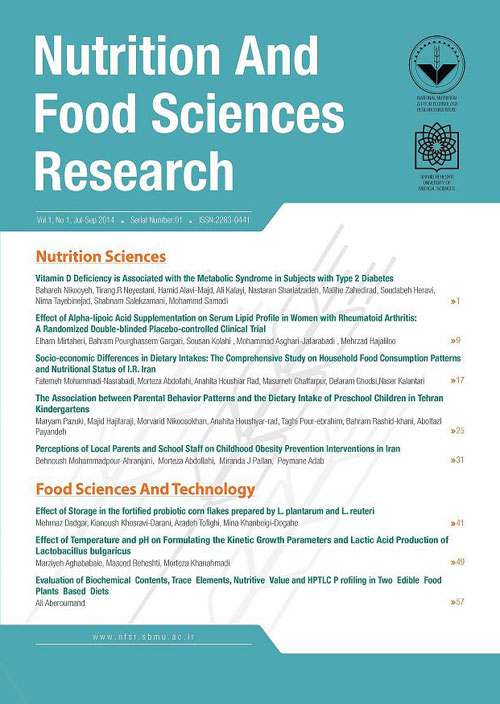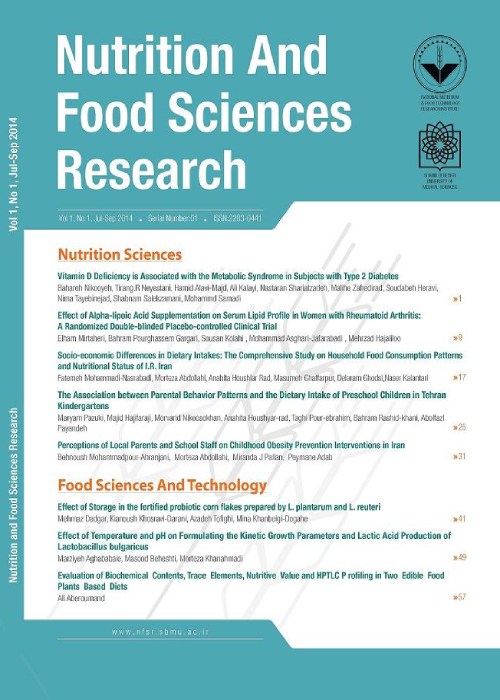فهرست مطالب

Nutrition & Food Technology Research
Volume:8 Issue: 4, Oct-Dec 2021
- تاریخ انتشار: 1400/08/01
- تعداد عناوین: 7
-
-
Pages 1-3
While world is fighting the COVID-19 pandemic, there is an infodemic of misinformation occurs that needs urgent attentions. This commentary underscores importance of media food and nutrition literacy (MFNL) and appropriate policies to improve MFNL and nutrition education as integral parts of the public health response to COVID-19 emergency as well as long-term investments during post COVID-19 era.
Keywords: food, nutrition literacy, COVID-19, media food -
Pages 5-11
In general, results of studies show that the nutritional status of boarding schools is unsatisfactory. Since adolescence is one of the most critical periods of growth, nutrition plays important roles in personal, social and mental health of the adolescents. Furthermore, results of studies from this review show that the intake of calorie and nutrients in most boarding school students is inadequate, especially in less developed countries. Therefore, interventions such as allocating further food budgets, using fortified foods, participating charities in providing foods and other requirements and using essential supplements such as vitamin D, iron and calcium should be carried out for these school students.
Keywords: Nutrition, Boarding School, Food, Adolescent, Iran -
Pages 13-18Background and Objectives
Cataract is the second cause of visual impairment and the first cause of blindness worldwide. This study was carried out to assess and compare quantities of caffeine consumption by cataract patients with healthy controls.
Materials and MethodsThis case-control study was carried out on 336 40–80 year-old participants (168 patients with cataract and 168 healthy individuals). Demographic data, including age, gender, occupation, level of education, economic and marital statuses, levels of physical activity and history of smoking and chronic diseases, were collected using personal information questionnaire. Independent t-test and Mann-Whitney test were used to compare quantitative variables between the two groups. Chi-square test was used to compare categorical variables. Logistic regression was used to investigate relationships between the consumption of caffeinated foods and beverages and the odds ratios (OR) of cataract.
ResultsResults showed that dietary consumption of caffeine played protective roles against occurrence of cataracts [OR: 0.982 (CI: 0.977, 0.988), p-value < 0.001]. Exposure to ultraviolet light of the sun was also a significant factor in increasing risks of cataract [OR: 2.32 (CI: 1.29, 4.19), p-value = 0.005].
ConclusionsIncreasing consumption of caffeinated foods and beverages can play protective roles against cataract.
Keywords: Cataract, Caffeinated foods, Protection, Iran -
Pages 19-27Background and Objectives
Overweight/obesity can be consequences or causative factors of depression. Vitamin D has been suggested as a contributing factor in depression and excessive body weight; however, the existing evidence is still unclear. The objective of this study was to assess statuses of overweight and obesity in patients with depression, considering possible roles of vitamin D.
Materials and MethodsA cross-sectional study was carried out on 56 18–60 year-old patients with mild to moderate depression. Demographic data were collected, serum 25(OH)D and anthropometric indices were assessed. Statuses of weight and abdominal obesity were assessed based on the body mass index (BMI), waist circumference (WC) and waist-to-hip ratio (WHR), respectively. Data analyses were carried out using SPSS Software v.21.
ResultsThe mean weight of the patients was 75.44 ± 14.52 kg. Moreover, 42.86 and 39.25% were overweight and obese indices, respectively. Most of the participants included abdominal obesity (96.43 and 60.71% based on WC and WHR, respectively). The mean of serum 25(OH)D was 80.37 ± 30.78 nmol l-1 . Results of multiple regression revealed that age was significantly linked to depression; however, this relationship was not statistically significant for anthropometric variables.
ConclusionsOverweight and obesity were prevalent in patients with mild to moderate depression. Appropriate preventive policy-making to carry out nutritional interventions with increasing physical activity (PA) seem necessary to decrease treatment costs in these patients.
Keywords: Depression, Obesity, Overweight, Vitamin D, Tehran -
Pages 29-36Background and Objectives
Melamine is an organic nitrogen used as an adulterant to increase nitrogen and protein contents in milks. Enzyme-linked immunosorbent assay has verified as a good alternative for rapid screening of melamine and other food additives instead of the laborious chromatography techniques.
Materials and MethodsIn the present study, MaxSignal enzyme-linked immunosorbent assay kit was used to screen melamine in 30 samples, including milks, infant formulas, chocolates, tea whiteners and pet foods. The kit was based on a competitive colorimetric enzyme-linked immunosorbent assay.
ResultsMelamine was detected in the range of 0.05–0.69 ppm in infant formula/milk powder samples and 0.001–0.042 ppm in liquid milk samples, which were under the set limits of Codex Alimentarius, 2012. Codex Alimentarius Commission adopted a maximum melamine level of 1 ppm for powdered infant formulas and of 2.5 ppm for other foods and animal foods. The commission has now set a maximum limit of 0.15 ppm for melamine in liquid milks. Further protein analyses of milk and infant formula samples were also carried out to verify the presence of melamine.
ConclusionsIt has been seen that enzyme-linked immunosorbent assay could effectively be used as a screening tool for detecting melamine in a wide range of food samples. Whereas, complementary techniques such as high-performance liquid chromatography, gas chromatography/mass spectrometry can be adopted as verification methods for regulatory compliance.
Keywords: Melamine, ELISA, Antibody, Kjeldahl method, HPLC, GC, MS -
Pages 37-44Background and Objectives
The aim of the present study was to investigate effects of incorporating Iranian native and commercial probiotic strains (Lactobacillus acidophilus, Lactobacillus casei and Bifidobacterium lactis) on the rheological and syneresis properties of yogurts.
Materials and MethodsSamples were heated (90 °C, 15 min) after reconstituting in milk (13% SNF). After cooling down, the starter culture and probiotics were incorporated. Incubation was carried out at 42 °C until the pH decreased to 4.5. Syneresis was assessed based on Amatayakul et al. method. Rheological characteristics were assessed using dynamic oscillation (strain sweep and frequency sweep) and rotation assays.
ResultsResults revealed significant improvement in characteristics of the probiotic yogurts, compared to the control sample. Based on the results of rheological assessments, yogurts showed viscoelastic behaviors. In general, yogurts containing the native strain of L. acidophilus provided further desirable rheological and syneresis characteristics.
ConclusionsTherefore, it is strongly recommended to use native Iranian L. acidophilus in probiotic yogurt production.
Keywords: Bifidobacterium, Lactobacillus, Yogurt, Rheological characteristics -
Pages 45-52Background and Objectives
Traditional fermented cereal beverages such as Obushera from sorghum and/or millet are commercialized owing to their popularity among consumers. However, Obushera separates into two phases after processing, which could be mistaken for spoilage. Additionally, Obushera has a limited shelf life of 4–7 days at room temperature. The objective of this study was to assess the potential of various stabilizers and preservatives for the production of acceptable shelf-stable Obushera.
Materials and MethodsEffects of seven treatments of 1) 0.4% xanthan gum, 2) 0.4% carboxymethyl cellulose, 3) Lactobacillus rhamnosus yoba, 4) 0.4% xanthan gum and Lactobacillus rhamnosus yoba, 5) 0.4% carboxymethyl cellulose and Lactobacillus rhamnosus yoba, 6) 0.4% xanthan gum and 0.4% carboxymethyl cellulose and Lactobacillus rhamnosus yoba, and 7) a control (no stabilizers) on sedimentation rate were assessed within 120 h at room temperature. Effects of four treatments of 1) pasteurization (90 °C for 10 min) and 0.25% xanthan gum, 2) pasteurization and 0.25% xanthan gum and 0.2% potassium sorbate and 3) pasteurization and 0.25% xanthan gum and 0.1% sodium-benzoate and 4) control (pasteurized with no additives) on shelf stability and consumer acceptability were investigated.
ResultsTreatments with xanthan (sedimentation index of 0–25%) for stabilizing Obushera were significantly (p < 0.05) more effective than those with no xanthan (sedimentation index of 49–67%). Xanthan (0.25%) significantly (p < 0.05) improved consumer acceptability of Obushera. All preservation treatments (p > 0.05) prolonged the shelf life of the beverage up to four months. No microbial growth was detected in the products during storage while pH (3.7–4.0) and acidity (0.5–0.6%) did not change significantly (p > 0.05). All products were acceptable during storage.
ConclusionsObushera and related products can be stabilized and preserved using xanthan (0.25%) and pasteurization (90 °C for 10 min) with no added preservatives.
Keywords: Sorghum, Fermented beverage, Obushera, Stabilization, Preservation, Lactobacillus rhamnosus


